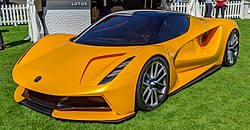Lotus Evija
| lotus | |
|---|---|
| Evija | |
| Production period: | since 2020 |
| Class : | Sports car |
| Body versions : | Coupe |
| Engines: |
Electric motors : 1471 kW |
| Length: | 4459 mm |
| Width: | 2000 mm |
| Height: | 1122 mm |
| Wheelbase : | |
| Empty weight : | 1680 kg |
The Lotus Evija is a limited-production battery-electric powered sports car manufactured by the British automobile manufacturer Lotus Cars .
history
The vehicle was unveiled in July 2019 and is the first electric car to be manufactured by Lotus Cars. The production of the Evija is limited to 130 pieces.
A prototype was subjected to a high-speed test in November 2019. A video was released on November 21, 2019 prior to its debut later that day at the Guangzhou Auto Show. Production of the series vehicle is scheduled to start in 2020.
Surname
The name "Evija" is derived from Eve of the Abrahamic religions . Translated from Hebrew, the name means "alive". Phil Popham, CEO of Lotus Cars said, “Evija is the perfect name for our new car as it is the first brand new car to come from Lotus as part of the larger Geely family. With Geely's support we will develop a new car. "
Specifications
The Evija is powered by a 70 kWh battery pack that was developed in collaboration with Williams F1 and whose electric motors are supplied by Integral Powertrain. Each of the four individual motors is located on one wheel and has an output of 368 kW (500 hp) with a total output of 1471 kW (2000 hp) and 1700 Nm of torque. The Lotus Evija is the first Lotus road car with a full carbon chassis. The Evija has magnesium wheels with diameters of 20 inches at the front and 21 inches at the rear, Auto Pirelli -Trofeo-R tires and AP-Racing carbon-ceramic disc brakes.
technology
Four compact electric motors transfer the power to each drive shaft with a target power of 500 hp per electric motor. The automatic torque vectoring made possible by the four electric motors can immediately distribute the power to any combination of two, three or four wheels within a fraction of a second. In the track mode, the radius of the curves can be reduced by giving individual wheels more power. There are five driving modes - range, city, tour, sport and route - with different vehicle performance features that can be activated or deactivated depending on the selection. The Evija is equipped with ESP stability control to ensure safety in all road conditions. The all-wheel drive provides additional grip. The steering takes place via an electro-hydraulic system.
performance
With a target output of 2000 hp and 1700 Nm torque, the Lotus Evija is set to become the most powerful series car in the world. Lotus claims that the Evija should accelerate from 0 to 100 km / h in less than three seconds and from 0 to 300 km / h in less than nine seconds. The maximum speed should be 320 km / h.
Web links
Individual evidence
- ↑ a b c Stefan Leichsenring: Lotus Evija (2019): The first Lotus with an electric drive has 2,000 hp. In: de.motor1.com. July 17, 2019, accessed July 9, 2020 .
- ↑ Stefan Wagner: Lotus Evija electric hypercar in motion for the first time. In: de.motor1.com. November 22, 2019, accessed July 9, 2020 .
- ↑ Andreas Wilkens: Electric cars: Lotus Evija with 2000 PS. In: heise.de. April 16, 2020, accessed July 9, 2020 .
- ↑ Andreas Haupt: Lotus Evija with 2,000 PS on a test drive: A superlative electric hypercar. In: auto-motor-und-sport.de. November 22, 2019, accessed July 9, 2020 .


